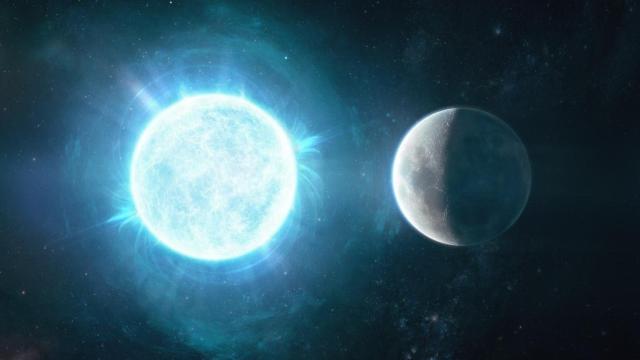Imagine a white-hot, dying star that contains more mass than our Sun packed into an orb just a little larger than our Moon. That’s ZTF J190132.9+145808.7, a record-setting white dwarf recently identified by astronomers.
The star was seen from the Zwicky Transient Facility, which operates out of California and Hawaii, hence the first letters in the object’s unwieldy name. Based on the object’s extreme magnetic field and mass — nearly a billion times as strong as the Sun and 1.35 times its mass — the researchers believe it is the result of a white dwarf merger. Their results were published this week in Nature.
White dwarfs (also called degenerate dwarfs) are the end stage of many small and medium-sized stars. When white dwarfs orbiting each other (in what’s called a binary star system) eventually merge, they can explode in a supernova. But if they aren’t that massive, they just form one bigger white dwarf. “We caught this very interesting object that wasn’t quite massive enough to explode,” said Ilaria Caiazzo, an astrophysicist at the California Institute of Technology and lead author of the paper, in a Keck Observatory press release. “We are truly probing how massive a white dwarf can be.”

ZTF J190132.9+145808.7 also has a very fast rotation, performing a full revolution in just under seven minutes. Its diameter is about 4,297 km, slightly more petite the previously known smallest white dwarfs, which both had diameters of about 4,989 km. Studying the strength of the star’s magnetic field in conjunction with its fast rotation led the research team to the conclusion that the dwarf was once two separate stars that came together in a dense, fast-spinning collab.
The team believes that ZTF J190132.9+145808.7 has a chance of turning into a neutron star, one possible end-stage of stellar life in which a star will end up collapsing in on itself. “It is so massive and dense that, in its core, electrons are being captured by protons in nuclei to form neutrons,” Caiazzo said in the same release. “Because the pressure from electrons pushes against the force of gravity, keeping the star intact, the core collapses when a large enough number of electrons are removed.”
Plenty of known unknowns abound, such as how strong magnetic fields arise from white dwarf mergers and the prevalence of such mergers among white dwarfs in space. The telescopes keep looking skywards, so as long as the dwarfs remain large enough to be seen, it’s safe to say there will be more record-breakers in the future.
More: Astronomers Discover First Known Planet to Orbit a White Dwarf Star
